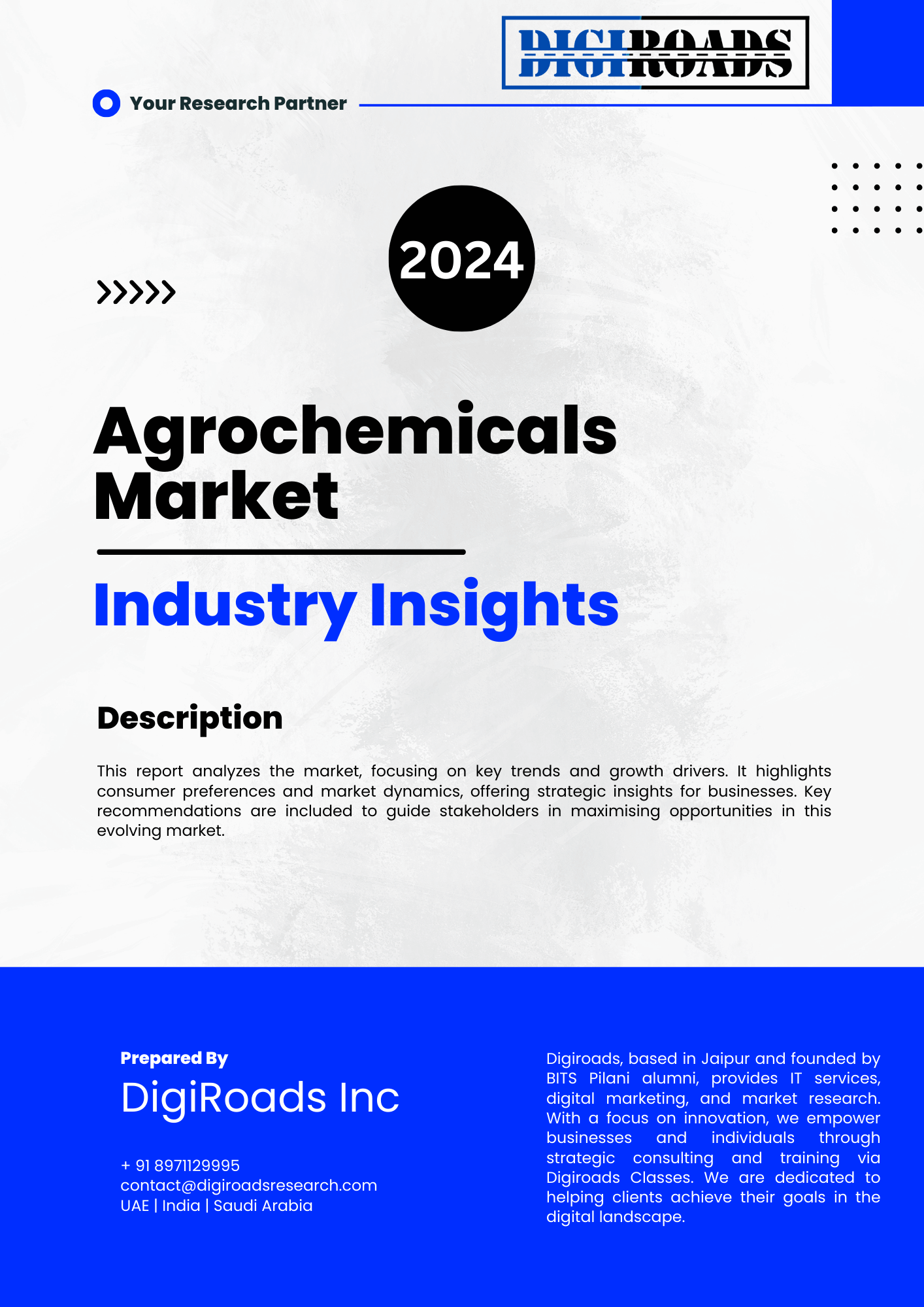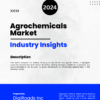Agrochemicals Market
- Brand: DigiRoads
The Agrochemicals Market report offers a detailed analysis of industry trends, market dynamics, and key players. Covering pesticides, fertilizers, and plant growth regulators, the 120-page report provides insights on market size, growth factors, and future projections.
Agrochemicals Market: Opportunity Analysis and Industry Forecast, 2024-2034
Agrochemicals Market Overview:
The agrochemicals market was valued at approximately US$ 240.06 billion in 2024 and is expected to reach around US$ 403.95 billion by 2034, poised to grow at a CAGR of 4.5%.
The agrochemicals market encompasses a broad range of chemical products used in agriculture to enhance crop yield, protect against pests and diseases, and improve soil fertility. Key segments include pesticides (insecticides, herbicides, fungicides), fertilizers (nitrogen, phosphorus, potassium), and plant growth regulators.
Driving factors in the agrochemicals market include increasing global population, shrinking arable land, and growing demand for food. Agrochemicals help address these challenges by improving agricultural productivity and crop quality.
However, the market faces challenges such as environmental concerns, regulatory restrictions, and resistance development in pests and weeds. Sustainable practices and the development of eco-friendly alternatives are gaining traction to address these issues.
Geographically, Asia-Pacific is the largest market for agrochemicals due to its vast agricultural sector, followed by North America and Europe. Emerging economies like India and China are witnessing significant growth in demand for agrochemicals due to increasing adoption of modern agricultural practices.
Overall, the agrochemicals market is essential for global food security and agricultural sustainability, driving innovation and investment in technologies to meet the growing demand for safe, efficient, and environmentally friendly solutions.
Agrochemicals Market- Report Coverage:
The “Agrochemicals Market Report – Forecast (2024-2034)” by Digiroads Consulting, covers an in-depth analysis of the following segments in the Agrochemicals Market Market.
| Attribute | Segment |
| By Product Type |
|
| By Application |
|
| By Pesticides Type |
|
| By Fertilizers Type |
|
| By Crop Type |
|
| By Location |
|
Agrochemicals Market Recent Developments :
Rise of Drone Technology:
- There’s a growing adoption of drone technology for precise and efficient application of agrochemicals. Collaborations like IFFCO and Drone Destination in India aim to enhance agricultural productivity through large-scale drone spraying .
Focus on Sustainability:
- Sustainability concerns are pushing the development of bio-based and eco-friendly alternatives to traditional agrochemicals. Companies are exploring natural pesticides and biostimulants to reduce environmental impact .
Merger and Acquisition Activity:
- Consolidation is happening within the industry. Mergers and acquisitions aim to expand product portfolios and geographical reach. For instance, recent news suggests ongoing discussions for a potential merger between two agrochemical giants .
Regulatory Landscape:
- Regulatory bodies are tightening regulations on traditional agrochemicals due to environmental and health concerns. This is pushing companies to invest in R&D for safer and more targeted products .
Technological Advancements:
- Precision agriculture is gaining traction. Technologies like advanced sensors and data analytics are being integrated to optimize fertilizer and pesticide use, reducing waste and maximizing yields .
Agrochemicals Market- Dynamics:
- Global Population Growth and Food Demand: The increasing global population drives demand for food, which in turn increases the need for agrochemicals to enhance crop yield and quality. Population growth, coupled with changing dietary habits and urbanization, fuels the demand for higher agricultural productivity.
- Technological Advancements: Advancements in agricultural biotechnology, genetics, and chemistry drive innovation in agrochemicals, leading to the development of more efficient and sustainable products. Integrated pest management (IPM) techniques and precision agriculture technologies further enhance the effectiveness of agrochemical applications.
- Regulatory Environment: Stringent regulations govern the use of agrochemicals to ensure environmental safety, consumer health, and food quality. Compliance with regulatory standards and registration requirements is essential for market access and product commercialization, influencing market dynamics and product development.
- Environmental Concerns: Growing environmental awareness and concerns about the impact of agrochemicals on ecosystems, water quality, and biodiversity drive demand for sustainable and eco-friendly alternatives. Biopesticides, organic fertilizers, and integrated pest management practices are gaining popularity as environmentally friendly solutions.
- Resistance Management: Pests, weeds, and diseases develop resistance to agrochemicals over time, posing challenges to pest management and crop protection. Integrated pest management (IPM) strategies, rotation of chemical classes, and the development of new active ingredients help mitigate resistance issues.
- Market Consolidation and Competition: The agrochemicals market is characterized by consolidation among key players through mergers, acquisitions, and strategic alliances. Intense competition drives innovation, product differentiation, and market expansion, influencing pricing, distribution channels, and market share.
- Geopolitical Factors: Geopolitical events, trade policies, and market access barriers impact the global agrochemicals market. Trade tensions, tariffs, and regulatory differences between countries affect market dynamics, supply chain resilience, and market competitiveness.
- Socioeconomic Trends: Socioeconomic factors such as income levels, consumer preferences, and government policies influence agrochemical usage patterns, market demand, and product innovation. Economic growth, rural development initiatives, and agricultural subsidies shape market dynamics in various regions.
Overall, the dynamics of the agrochemicals market are multifaceted, with interplay between global population trends, technological advancements, regulatory frameworks, environmental concerns, resistance management, market competition, geopolitical factors, and socioeconomic trends shaping market growth, innovation, and sustainability. Adapting to these dynamics is essential for stakeholders to capitalize on opportunities and address challenges effectively in the agrochemicals market.
Key Market Players:
Product/Service launches, approvals, patents and events, acquisitions, partnerships and collaborations are key strategies adopted by players in the Agrochemicals Market. The top 10 companies in this industry are listed below:
- Bayer CropScience
- Syngenta
- BASF
- Dow AgroSciences
- Monsanto (now part of Bayer)
- DuPont (now part of Corteva Agriscience)
- FMC Corporation
- Sumitomo Chemical
- Nufarm
- UPL Limited
Key Benefits For Stakeholders:
Increased Crop Yield and Quality: Agrochemicals such as fertilizers, pesticides, and plant growth regulators help enhance crop yield, improve crop quality, and increase farm productivity, leading to higher profitability for farmers and agribusinesses.
Crop Protection: Pesticides protect crops from pests, diseases, and weeds, reducing yield losses and ensuring food security. Agrochemicals contribute to sustainable agriculture by minimizing crop damage and losses caused by pests and diseases.
Improved Soil Fertility: Fertilizers provide essential nutrients to crops, replenishing soil fertility and promoting healthy plant growth. Agrochemicals help maintain soil health, improve nutrient uptake efficiency, and prevent soil degradation, ensuring long-term agricultural sustainability.
Efficient Resource Utilization: Agrochemicals optimize resource utilization by providing crops with the nutrients and protection they need for healthy growth. Efficient use of fertilizers and pesticides minimizes resource wastage and maximizes agricultural productivity, leading to cost savings for farmers.
Economic Growth and Development: The agrochemicals industry contributes to economic growth and development by supporting agricultural livelihoods, creating employment opportunities, and generating revenue for input suppliers, manufacturers, distributors, and retailers.
Innovation and Research Investment: Stakeholders benefit from continuous innovation and research investment in agrochemicals, leading to the development of new and improved products, formulations, and application technologies that enhance agricultural efficiency and sustainability.
Market Competitiveness: Agrochemicals enable farmers to remain competitive in the global marketplace by increasing crop yields, reducing production costs, and meeting quality and safety standards demanded by consumers and regulatory authorities.
Food Security: Agrochemicals play a crucial role in ensuring food security by increasing agricultural productivity, improving food availability, and mitigating the impact of biotic and abiotic stresses on crop production, particularly in regions prone to food shortages and famine.
We have studied the Agrochemicals Market Marketin 360 degrees via. both primary & secondary research methodologies. This helped us in building an understanding of the current market dynamics, supply-demand gap, pricing trends, product preferences, consumer patterns & so on. The findings were further validated through primary research with industry experts & opinion leaders across countries. The data is further compiled & validated through various market estimation & data validation methodologies. Further, we also have our in-house data forecasting model to predict market growth up to 2034.
Contact us for any inquiry.
Table of Contents
- INTRODUCTION
1.1 Study Assumptions & Market Definition
1.2 Scope of the Study
- RESEARCH METHODOLOGY
- EXECUTIVE SUMMARY
- MARKET DYNAMICS
4.1 Market Overview
4.2 Market Drivers
4.3 Market Restraints
4.4 Porter’s Five Forces Analysis
4.4.1 Bargaining Power of Suppliers
4.4.2 Bargaining Power of Buyers
4.4.3 Threat of New Entrants
4.4.4 Threat of Substitute Products
4.4.5 Intensity of Competitive Rivalry
- MARKET SEGMENTATION
- Agrochemicals Market– By Type
- Herbicides
- Insecticides
- Fungicides
- Biopesticides
- Plant Growth Regulators
- Fertilizers
- Agrochemicals Market– By Application
-
-
- Crop Protection
- Seed Treatment
- Soil Treatment
- Foliar Spray
- Post-Harvest Treatment
-
- Agrochemicals Market– By pesticides
-
-
- Glyphosate
- Chlorpyrifos
- Neonicotinoids
- Paraquat
- Atrazine
-
- By Fertilizer type:
- Nitrogen Fertilizers
- Phosphorus Fertilizers
- Potassium Fertilizers
- Compound Fertilizers
- Organic Fertilizers
- By Crop Type:
- Corn
- Wheat
- Rice
- Soybeans
- Cotton
- Vegetables (e.g., tomatoes, potatoes)
- Fruits (e.g., apples, oranges)
- Sugarcane
- Oilseeds (e.g., sunflower, canola)
- Legumes (e.g., peas, beans)
- By Location :
- North America
- Europe
- Asia-Pacific
- Latin America
- Middle East & Africa
- COMPETITIVE LANDSCAPE
6.1 Most Adopted Strategies
6.2 Market Share Analysis
6.3 Company Profiles
- Bayer CropScience
- Syngenta
- BASF
- Dow AgroSciences
- Monsanto (now part of Bayer)
- DuPont (now part of Corteva Agriscience)
- FMC Corporation
- Sumitomo Chemical
- Nufarm
- UPL Limited
- MARKET OPPORTUNITIES AND FUTURE TRENDS


